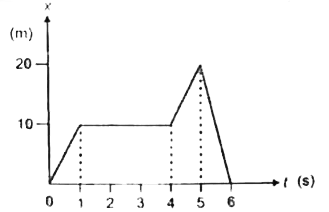The motion of a particle is described by the equation x=a+bt2 where a=15 cm and b=3cm/s2. Its instantaneous velocity at time 3 sec will be
33cms−1
18cms−1
16cms−1
32cms−1
The correct Answer is:A
To find the instantaneous velocity of the particle at time t=3 seconds, we start with the given position equation:
x=a+bt2
where a=15 cm and b=3 cm/s².
Step 1: Differentiate the position equation with respect to time
The instantaneous velocity v is given by the derivative of the position x with respect to time t:
v=dxdt
Step 2: Differentiate the equation
Now, we differentiate the equation x=a+bt2:
- The derivative of a (a constant) with respect to t is 0.
- The derivative of bt2 with respect to t is 2bt.
Thus, we have:
v=0+2bt=2bt
Step 3: Substitute the values of b and t
Now we substitute b=3 cm/s² and t=3 s into the equation for velocity:
v=2⋅3⋅3
Step 4: Calculate the instantaneous velocity
Calculating the above expression gives:
v=2⋅3⋅3=18 cm/s
Conclusion
The instantaneous velocity of the particle at t=3 seconds is:
v=18 cm/s
The instantaneous velocity v is given by the derivative of the position x with respect to time t:
Now, we differentiate the equation x=a+bt2:
- The derivative of bt2 with respect to t is 2bt.
Now we substitute b=3 cm/s² and t=3 s into the equation for velocity:
Calculating the above expression gives:
The instantaneous velocity of the particle at t=3 seconds is:
Topper's Solved these Questions
- BOOK - NCERT FINGERTPS ENGLISHCHAPTER - MOTION IN A STRAIGHT LINEEXERCISE - ACCELERATION19videos
MOTION IN A STRAIGHT LINE
- BOOK - NCERT FINGERTPS ENGLISHCHAPTER - MOTION IN A STRAIGHT LINEEXERCISE - KINEMATIC EQUATIONS FOR UNIFORMLY ACCELERATED MOTION32videos
MOTION IN A STRAIGHT LINE
- BOOK - NCERT FINGERTPS ENGLISHCHAPTER - MOTION IN A STRAIGHT LINEEXERCISE - AVERAGE VELOCITY AND AVERAGE SPEED8videos
MOTION IN A STRAIGHT LINE
- BOOK - NCERT FINGERTPS ENGLISHCHAPTER - MOTION IN A PLANE EXERCISE - Assertion And Reason15videos
MOTION IN A PLANE
- BOOK - NCERT FINGERTPS ENGLISHCHAPTER - OSCILLATIONS EXERCISE - Assertion And Reason15videos
OSCILLATIONS
Similar Questions
The motion of a particle along a straight line is described by the function x=(2t−3)2, where x is in metres and t is in seconds. Find
(a) the position, velocity and acceleration at t=2s.
(b) the velocity of the particle at origin.View SolutionThe motion of a particle along a straight line is described by the function x=(2t−3)2, where x is in metres and t is in seconds. Find
(a) the position, velocity and acceleration at t=2s.
(b) the velocity of the particle at origin.View SolutionA particle is moving along x-axis. The position of the particle at any instant is given by x=a+bt2 where ,a= 6 m and b= 3.5 ms−2 't' is measured in second .Find
(i) the velocity of the particle at 1s and
(ii) the average velocity between 3s and 6sView SolutionA particle is moving along x-axis. The position of the particle at any instant is given by x=a+bt2, where, a=6mandb=3.5ms−2, t is measurved in seconds. Find.
Velocity of the particle at t = 0 and t = 3sView SolutionPosition of a particle at any instant is given by x=3t2+1 , where x is in m and t in sec. Its average velocity in the time interval t=2 sec to t=3 sec will be :
View SolutionIf the particle is moving along a straight line given by the relation x=2−3t+4t3 where s is in cms., and t in sec. Its average velocity during the third sec is
View SolutionThe motion of a particle along a straight line is described by equation : x=8+12t−t3 where x is in metre and t in second. The retardation of the particle when its velocity becomes zero is.
View SolutionThe motion of a particle along a straight line is described by equation : x=8+12t−t3 where x is in meter and t in second. The retardation of the particle when its velocity becomes zero is.
View SolutionThe motion of a particle along a straight line is described by the function s=6+4t2−t4 in SI units. Find the velocity, acceleration, at t = 2s, and the average velocity during 3rd second.
View SolutionFigure shows the graph of x - coordinate of a particle moving along x - axis as a function of time. Average velocity during t = 0 to 6 s and instantaneous velocity at t = 3 s respectively, will be
 View Solution
View Solution

